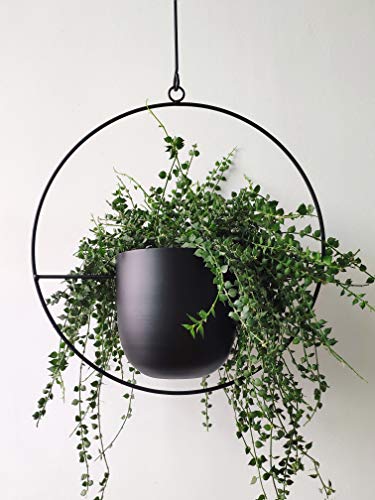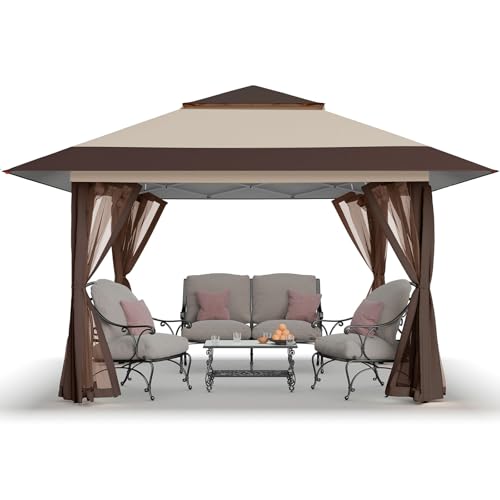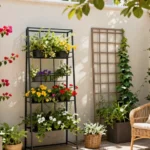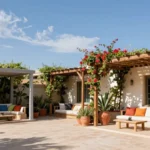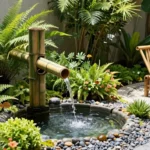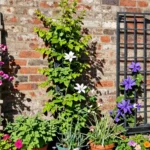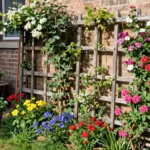Finding the perfect outdoor sanctuary for your furry friend shouldn’t feel overwhelming. We’ve all watched our dogs seek shelter under porches or huddle against walls during harsh weather, and it breaks our hearts. The right outdoor dog house isn’t just about protection—it’s about creating a space where your pet feels secure and comfortable year-round.
Today’s dog house options go far beyond basic wooden boxes. From elevated designs that prevent moisture buildup to insulated models for extreme climates, we’ll explore creative answers that match both your dog’s needs and your yard’s aesthetic. Whether you’re dealing with a tiny terrier or a gentle giant, there’s an outdoor shelter design that’ll make both you and your pup happy.
Classic Wooden Dog House Designs
Wooden dog houses remain the most popular choice among pet owners for their timeless appeal and natural durability. These traditional structures offer excellent insulation properties and can be customized to match your home’s exterior design perfectly.
Traditional A-Frame Style Houses
A-frame designs provide optimal weather protection through their steep sloped roofs that shed rain and snow effectively. We recommend these triangular structures for areas with heavy precipitation since water runs off quickly without pooling on the roof surface.
Key features of A-frame dog houses include:
- Elevated floors that prevent moisture buildup and improve air circulation
- Easy assembly with simple geometric construction requiring minimal tools
- Compact design that maximizes interior space while maintaining a small footprint
- Removable roof panels for convenient cleaning and maintenance access
Standard A-frame houses work best for medium-sized dogs like Golden Retrievers and Labrador Retrievers. The triangular shape creates natural ventilation that keeps pets cool during summer months while the enclosed design provides warmth in winter.
Rustic Log Cabin Inspired Shelters
Log cabin style dog houses bring frontier charm to your backyard while offering superior thermal regulation. These designs feature interlocking wooden logs that create natural insulation gaps filled with chinking material for enhanced weather protection.
Popular log cabin features include:
- Half-log siding that mimics authentic cabin construction without excessive weight
- Wraparound porches that provide shaded outdoor lounging areas
- Green metal roofing that complements the natural wood aesthetic
- Multiple room layouts for families with several dogs
We find these shelters particularly appealing for larger breeds like German Shepherds and Great Danes who need spacious accommodations. The rustic appearance blends seamlessly with wooded properties and mountain-style landscaping.
Cedar and Pine Construction Benefits
Cedar and pine woods offer distinct advantages for outdoor dog house construction due to their natural resistance to insects and decay. These softwoods are lightweight yet strong enough to withstand harsh weather conditions for many years.
| Wood Type | Natural Properties | Average Lifespan | Maintenance Level |
|---|---|---|---|
| Cedar | Insect repelling oils, decay resistant | 15-20 years | Low |
| Pine | Affordable, easy to work with | 10-15 years | Medium |
| Pressure-treated Pine | Enhanced weather protection | 20-25 years | Low |
Cedar houses require minimal maintenance since the wood contains natural preservatives that prevent rot and insect damage. Pine construction costs significantly less while still providing adequate protection when properly sealed with weatherproof stain or paint.
Both wood types accept custom staining and painting well, allowing you to match your dog’s house to your home’s color scheme. We suggest choosing cedar for long term investment or pine for budget conscious projects that still deliver reliable shelter performance.
Modern Minimalist Dog House Concepts
We’re embracing the shift toward contemporary design with dog houses that prioritize simplicity and functionality. Modern pet architecture focuses on creating shelter that complements today’s outdoor spaces rather than competing with them.
Sleek Geometric Shapes and Clean Lines
Rectangular and cubic forms define the foundation of modern dog house design. We recommend structures that feature crisp edges and streamlined silhouettes to create visual harmony with contemporary patios and structured yards. Slatted panels add texture while maintaining the clean aesthetic these designs demand.
DIY Scandinavian-inspired builds showcase how geometric simplicity creates both style and function. Vertical slats or horizontal paneling provides striking linear patterns that catch the eye without overwhelming smaller outdoor spaces. These designs work particularly well for medium-sized dogs who need reliable shelter with modern appeal.
Sharp angles and minimal ornamentation ensure these houses integrate seamlessly into minimalist garden setups. We’ve found that geometric dog houses complement structured landscaping better than traditional rounded or ornate designs.
Contemporary Materials Like Metal and Composite
Metal frames paired with wooden slats offer superior weather resistance compared to traditional all-wood construction. We’re seeing more pet owners choose composite panels for their durability and refined appearance in urban environments. These materials require less maintenance while providing the sleek look modern design demands.
High-quality plastics and composite materials resist fading and warping better than conventional options. Metal components add structural integrity and create interesting visual contrasts when combined with natural wood elements. We recommend these material combinations for pet owners who prioritize longevity and easy upkeep.
Weather-resistant composites maintain their appearance through multiple seasons without regular staining or sealing. These contemporary materials align perfectly with minimalist design philosophies that value both form and function.
Flat Roof Designs for Urban Settings
Flat roofs provide the contemporary silhouette that urban pet owners prefer for compact spaces. We’re recommending these designs for patios, balconies, and small yards where traditional sloped roofs might appear oversized. Boxy forms with straight lines maximize vertical space efficiency without sacrificing weather protection.
Platform functionality transforms flat-roof dog houses into dual-purpose outdoor furniture. Some designs can double as seating areas or plant displays when positioned strategically in limited spaces. We’ve observed that flat roof profiles work especially well in modern architectural settings where consistency matters.
Urban environments benefit from dog houses that mirror the clean lines found in contemporary buildings. Flat roof designs eliminate the visual weight that peaked roofs create, making them ideal choices for minimalist outdoor living spaces that emphasize simplicity over ornamentation.
Weather-Resistant Dog House Solutions
Weather protection forms the foundation of any quality outdoor dog house design. We’ve researched the most effective approaches to shield your pet from harsh conditions year-round.
Insulated Winter-Ready Structures
Double-walled construction with proper insulation creates the most effective barrier against cold temperatures. We recommend installing foam boards or fiberglass batts within walls, roofs, and floors to maximize heat retention during harsh winters.
Positioning your dog house on casters or raising it off the ground keeps the floor significantly warmer while allowing easy cleaning access underneath. This elevation technique prevents ground moisture from seeping through and creating uncomfortable conditions for your pet.
Painting the exterior white offers a practical dual benefit by reflecting summer heat while maintaining internal warmth during winter months. This simple color choice can reduce temperature fluctuations throughout seasonal changes.
Floor insulation deserves special attention since cold ground contact can quickly drain your dog’s body heat. Adding thick foam boards beneath flooring materials creates an effective thermal barrier that maintains comfortable temperatures even in freezing conditions.
Elevated Designs for Flood Protection
Raising dog houses above ground level prevents flooding and moisture buildup that can cause serious health issues for your pet. We suggest using sturdy legs or platform systems to keep structures well above potential water accumulation areas.
Flood prone regions require additional height considerations to account for historical water levels in your area. Installing adjustable leg systems allows you to modify elevation based on seasonal weather patterns or changing industry conditions.
Platform designs offer superior drainage by allowing water to flow freely underneath rather than pooling around the structure. This continuous airflow also reduces humidity levels that can promote mold growth and create unhealthy living conditions.
Foundation materials like treated lumber or metal frameworks provide long-lasting support that won’t deteriorate when exposed to moisture. These durable options maintain structural integrity even during extended periods of wet weather.
Ventilation Features for Hot Climates
Strategic ventilation placement creates natural airflow that prevents dangerous overheating during summer months. We recommend cutting ventilation holes near the top of back walls to allow hot air to escape while fresh air enters through door openings.
Additional vents positioned on opposite walls create cross-ventilation that significantly improves air circulation throughout the interior space. This airflow pattern helps maintain comfortable temperatures even during peak heat periods.
Skylights or removable roof panels provide extra light and ventilation options without compromising weather protection. These features allow you to customize airflow based on daily temperature changes and seasonal requirements.
Fan installations offer active cooling answers for extremely hot climates where passive ventilation isn’t sufficient. Solar-powered options provide energy-efficient operation that doesn’t require electrical connections or increase utility costs.
Door positioning plays a crucial role in ventilation effectiveness by serving as the primary fresh air intake point. Properly sized openings create optimal airflow while maintaining protection from wind-driven rain and debris.
DIY Budget-Friendly Dog House Projects
Building a comfortable shelter for your furry friend doesn’t have to expensive. We’ve compiled cost-effective approaches that use affordable materials and simple construction techniques to create durable outdoor dog houses.
Pallet Wood Construction Ideas
Pallet wood offers an excellent foundation for budget-conscious dog house projects because it’s often available for free or at minimal cost. Sturdy planks from deconstructed pallets provide ready-made walls, roofing materials, and flooring components that reduce both material expenses and construction time.
Sustainability benefits make pallet wood construction particularly appealing since we’re essentially upcycling materials that might otherwise end up in landfills. Weather-resistant finishing transforms these reclaimed planks into durable shelter components that can withstand outdoor conditions for years.
Construction versatility allows us to mix and match pallet boards with standard lumber like 2x4s to create custom designs. We recommend thoroughly inspecting pallets for damage and treating the wood with appropriate sealers before assembly to ensure longevity.
Repurposed Materials and Upcycling Options
Creative material sourcing extends far beyond pallet wood to include various household items and construction leftovers. Old furniture parts such as cabinet doors, drawer fronts, and shelving can become walls or roofing elements with minimal modification.
Vinyl siding scraps provide excellent weather protection and can often be obtained inexpensively from construction sites or home improvement stores. These materials require minimal maintenance and offer superior moisture resistance compared to untreated wood.
Salvaged shingles represent another cost-effective roofing solution that ensures weatherproof protection while maintaining an attractive appearance. We can source these materials from roofing contractors or home renovation projects at important savings compared to new materials.
Paint and hardware remnants from previous projects help customize the appearance while keeping expenses low. Insulation scraps can improve thermal efficiency without purchasing full packages of new materials.
Step-by-Step Building Plans for Beginners
Detailed free plans from sources like The Spruce Pets offer 14 different dog house designs including traditional styles, mobile versions, and decorative options with windows and shutters. These comprehensive guides include illustrated instructions and photographs that simplify the construction process.
Wilker Do’s insulated dog house plans provide exact dimensions and complete material lists perfect for woodworking newcomers. Basic tools and materials like pine boards, 2x4s, and plywood keep the project accessible to most DIY enthusiasts.
Construction stages typically follow a logical progression: building the base frame, erecting wall panels, installing the roof structure, and applying finishing touches. Home Depot and Lowe’s guides include pre-drilling techniques that prevent wood splitting and ensure professional-looking results.
Material shopping lists accompanying these plans help us estimate costs accurately and avoid multiple trips to the hardware store. Simple techniques and basic lumber choices like pine boards and plywood make these projects achievable even for beginners with minimal woodworking experience.
Luxury Designer Dog House Ideas
We’ve explored practical and budget-friendly options, but now it’s time to discover the ultimate in canine luxury. These premium dog houses combine sophisticated design with top-tier amenities that rival human accommodations.
Multi-Room Canine Mansions
Multi-room canine mansions offer separate living spaces that mirror human home layouts on a smaller scale. These custom designs feature distinct sleeping areas, lounging spaces, and charming porches or decks that provide dogs with multiple zones for different activities. Larger breeds especially benefit from these spacious configurations, as they can move between areas for resting and playing. Separate room layouts cater to dogs who enjoy having options for their daily routines, creating a truly personalized living experience.
Climate-Controlled Premium Features
Climate-controlled dog houses incorporate advanced insulation and ventilation systems to maintain optimal temperatures year-round. These premium features include heating and cooling units that protect pets from extreme weather conditions, whether it’s scorching summer heat or freezing winter temperatures. Double-walled construction with specialized insulation materials ensures consistent interior temperatures, while sophisticated ventilation systems prevent humidity buildup. Advanced materials and design techniques work together to create a comfortable microclimate that keeps dogs healthy and content regardless of outdoor conditions.
Architectural Details and Decorative Elements
Architectural details transform ordinary dog houses into stunning miniature homes that enhance any yard’s aesthetic appeal. Pitched and gabled roofs create classic silhouettes, while mini shuttered windows and decorative trim add charming visual interest. Faux stone pathways lead to these designer structures, complemented by stylish lighting fixtures like battery-powered lanterns that illuminate the space beautifully. Decorative cushions and rugs in coastal, modern, or woodland themes create cozy interiors that match the owner’s style preferences. These luxury touches make each dog house a true designer canine mansion, with custom options typically starting around $6,000 through collaborative design processes.
Space-Saving Small Yard Dog Houses
We’ll explore innovative answers that maximize functionality while minimizing footprint impact in your outdoor space. Compact dog houses optimize limited areas without compromising your pet’s comfort or security.
Compact Corner-Fitting Designs
Corner-fitting dog houses use otherwise wasted angular spaces in your yard effectively. Triangular and pentagon-shaped designs nest comfortably into corners while freeing up central yard space for other activities. These structures can integrate seamlessly with existing fencing or kennel areas.
Traditional and modern corner designs both offer excellent space optimization. Slanted roofs and vertical awnings add visual interest without expanding the footprint significantly. We recommend building these houses using 2x4s and 2x2s for quick construction that fits snugly into tight corners.
Integration with existing yard features makes corner houses particularly practical. Fence-adjacent placement creates a natural backdrop while maintaining easy access for cleaning and maintenance.
Vertical Multi-Level Structures
Multi-level dog houses build upward rather than outward to maximize small footprints. These vertical designs provide separate areas for play, rest, and feeding within a compact base. Ramps or stairs connect different levels and promote exercise engagement.
Dollhouse-style structures feature windows and steep roofs that create visual appeal. Loft-style insulated designs keep pets warm and dry while offering multiple functional zones. We suggest incorporating removable panels for easy cleaning access between levels.
Elevated platforms prevent moisture buildup while creating distinct activity areas. Storage compartments can be built into lower levels for toys and supplies without requiring additional yard space.
Foldable and Portable Options
Portable dog houses offer flexibility for changing weather conditions or yard usage patterns. Lightweight foldable panels allow easy relocation without permanent installation requirements. Mobile designs with wheels enable quick repositioning throughout your outdoor space.
Portable gazebos made from metal panels provide UV and water resistance with simple setup processes. Fabric roofs offer protection while maintaining lightweight portability for travel or seasonal storage. We recommend these options for pet owners prioritizing convenience without sacrificing comfort.
Modular systems allow expansion or reconfiguration as your needs change. Quick assembly designs typically require no tools and can be set up in minutes for immediate use.
Custom Dog House Ideas by Breed Size
When selecting the perfect outdoor dog house, we must consider our furry friend’s exact size requirements to ensure maximum comfort and functionality. Different breed sizes demand unique design approaches that balance space efficiency with weather protection.
Large Breed Spacious Accommodations
Large dogs require significantly more room to move comfortably inside their outdoor shelters. We recommend structures with reinforced frameworks using galvanized steel combined with wood to support bigger frames and provide superior durability. Spacious kennels featuring wire fences and gravel flooring keep large breeds safe while preventing muddy paws from tracking dirt indoors.
Modern designs blend aesthetic appeal with practical functionality through metal panel kennels equipped with UV and water resistant fabric roofs. These innovative structures ensure complete weather protection while offering easy mobility for seasonal adjustments. Hinged roof designs help effortless cleaning and maintenance access, making upkeep simple for busy pet owners.
Insulated structures become essential for large breeds spending extended periods outdoors during colder months. Double walled construction with proper insulation materials helps retain body heat while protecting against harsh winter conditions.
Medium Dog Proportioned Shelters
Medium sized dogs benefit from perfectly balanced accommodations that provide adequate roominess without creating wasted space. We suggest gazebo style kennels constructed from durable metal panels that offer attractive, roomy enclosures specifically customized for medium breeds. These designs typically incorporate protective roofs for shade and comprehensive shelter from various weather elements.
Wood based dog houses featuring charming architectural details like functional windows, decorative shutters, and classic pitched roofs deliver both practical functionality and visual appeal. DIY wooden doghouse plans utilizing pine, plywood, and cedar shingles create long lasting structures with impressive aesthetic value.
Custom built options and pre designed kits provide flexibility for different budgets and skill levels. Online platforms like Etsy and Home Depot offer comprehensive plans and patterns that guide construction from start to finish.
Small Dog Cozy Retreats
Small dogs thrive in cozy retreat style shelters that emphasize warmth retention, superior insulation, and snug fitting dimensions. We prioritize compact designs featuring protected rear zones that provide extra weather shielding during storms and extreme temperature fluctuations.
Portable and mobile dog house designs work exceptionally well for small breeds, allowing owners to relocate structures easily for optimal sun exposure or shade throughout different seasons. These lightweight options adapt to changing yard conditions and weather patterns.
Artistic designs resembling miniature dollhouses with decorative window panes and charming architectural elements create delightful outdoor spaces perfectly suited for smaller breeds. These creative approaches combine functionality with whimsical appeal that enhances any backyard industry.
Insulated small dog houses protect petite pets from cold weather challenges while maintaining comfortable interior temperatures. Strategic ventilation features prevent overheating during warmer months while preserving essential warmth during winter conditions.
Multi-Functional Dog House Designs
Modern outdoor dog houses have evolved beyond simple shelters to become versatile structures that serve multiple purposes in our yards. We’re seeing designs that cleverly integrate additional features while maintaining their primary function of protecting our pets.
Storage Integration Features
Built-in storage compartments transform ordinary dog houses into organized pet supply centers. These integrated answers include shelves, drawers, and cubbies designed specifically for leashes, toys, food containers, and grooming supplies. We recommend positioning storage areas near the entrance for easy access during daily routines.
Side-mounted compartments keep pet accessories weatherproof and readily available. Many DIY plans now incorporate waterproof storage boxes that attach to the exterior walls without compromising the interior space. These additions help us maintain tidy outdoor areas while ensuring everything our dogs need stays within arm’s reach.
Under-floor storage spaces maximize functionality without increasing the house’s footprint. Raised designs naturally create cavities beneath the structure that can be enclosed and accessed through hinged panels. We find this approach particularly useful for storing seasonal items like winter blankets or summer cooling mats.
Planter Box Combinations
Integrated planter boxes create natural cooling zones around dog houses while improving yard aesthetics. These living additions can be built into the base perimeter or mounted along roof edges to provide shade and improve air quality. We suggest using native plants that require minimal maintenance and can withstand our local climate conditions.
Rooftop garden installations turn dog houses into functional industry features. Shallow planter systems designed for the roof surface add visual interest while providing insulation benefits. We’ve found that succulent gardens work exceptionally well for these applications since they’re drought-tolerant and lightweight.
Surrounding garden beds encourage natural behaviors and create comfortable microclimates. Plants positioned strategically around the dog house can block harsh winds while allowing beneficial breezes to flow through. We recommend herbs like lavender or rosemary that naturally repel insects while creating pleasant scents.
Seating Area Additions for Owners
Attached bench seating creates bonding spaces where we can comfortably spend time with our pets outdoors. These additions typically extend from one side of the dog house and can include weatherproof cushions or built-in storage underneath. We find that L-shaped configurations work best for maximizing seating while maintaining the structure’s proportions.
Covered porch extensions provide shade for both pets and owners during hot weather. These small roofed areas can accommodate folding chairs or built-in seating while protecting us from sun and light rain. We recommend sizing these spaces to accommodate at least two adults comfortably.
Multi-level deck platforms serve as observation posts and relaxation areas. Stepped designs allow us to sit at different heights while our dogs move freely between levels. We’ve seen designs that incorporate cup holders, magazine racks, and even small side tables to enhance the outdoor experience.
Eco-Friendly Sustainable Dog House Options
Building sustainable outdoor dog houses allows us to create comfortable shelters while minimizing our environmental impact. These innovative designs combine renewable energy, recycled materials, and living systems to benefit both pets and the planet.
Solar-Powered Heating Systems
Solar roof panels transform traditional dog houses into energy efficient shelters that harness renewable power. These systems generate electricity to operate heating pads or radiant heat elements inside the structure, reducing our reliance on fossil fuels and lowering energy costs. Modern solar powered dog houses feature integrated photovoltaic panels that blend seamlessly with stylish roofing designs.
We can install battery storage systems to maintain consistent warmth during cloudy days and nighttime hours. Solar heating technology works particularly well in regions with abundant sunshine, providing sustainable temperature control throughout colder months. These systems typically require minimal maintenance while delivering reliable performance for years.
Recycled Material Construction
Recycled materials offer exceptional durability while reducing landfill waste in our dog house projects. Insulation made from 100% recycled plastic bottles, such as Thinsulate by 3M, provides lightweight warmth equivalent to traditional down filling. Composite materials created from recycled plastics mimic natural wood textures while delivering superior weather resistance.
Reclaimed wood adds character and sustainability to our builds, especially when sourced from old barns or construction projects. Recycled composite roofing shingles protect against harsh weather while reducing raw material consumption. We can incorporate salvaged metal components for structural reinforcement, creating unique designs that showcase creative reuse principles.
Green Roof Living Systems
Green roofs create natural insulation systems that regulate temperature throughout seasonal changes. These living roofs consist of specially designed planters filled with soil and vegetation that absorb summer heat while retaining winter warmth. The plant layer supports local biodiversity, improves air quality, and manages rainwater runoff effectively.
Redwood dog houses with green roofs combine naturally decay resistant lumber with thriving vegetation to create eco friendly microenvironments. We recommend selecting drought tolerant plants like sedums or native grasses that require minimal irrigation. These systems provide additional benefits including reduced noise pollution and extended roof lifespan through natural protection from UV rays and temperature fluctuations.
Conclusion
Finding the perfect outdoor dog house doesn’t have to be overwhelming when you understand your options. Whether you’re drawn to classic wooden designs or modern minimalist concepts there’s a solution that’ll meet both your budget and your pet’s needs.
We’ve shown you that comfort and style can coexist beautifully. From eco-friendly sustainable options to luxury designer mansions the possibilities are endless. The key is matching your dog’s size breed and your yard’s unique requirements.
Remember that the best dog house is one that keeps your furry friend safe comfortable and happy year-round. With the right planning materials and design approach you’ll create an outdoor sanctuary that both you and your pet will love for years to come.
Frequently Asked Questions
What are the key features to look for in an outdoor dog house?
Look for elevated floors to prevent moisture, proper insulation for weather protection, adequate ventilation for airflow, and durable materials like cedar or composite. The house should be appropriately sized for your dog breed, with steep roofs for rain runoff and removable panels for easy maintenance.
Which materials are best for building a dog house?
Cedar is ideal for long-term investment due to its natural insect resistance and durability, while pine offers a budget-friendly option. Modern alternatives include metal and composite materials, which provide superior weather resistance and require less maintenance than traditional wood.
How do I choose the right size dog house for my pet?
Large dogs need spacious accommodations with reinforced frameworks, medium dogs benefit from gazebo-style or A-frame designs, and small dogs thrive in cozy retreat-style shelters. The house should allow your dog to stand, turn around, and lie down comfortably without being too large.
What are the most weather-resistant dog house features?
Double-walled construction with proper insulation, elevated foundations to prevent flooding, strategic ventilation for hot climates, and steep-angled roofs for rain and snow runoff. Materials like cedar, metal, or composite offer superior weather resistance compared to untreated wood.
Can I build a dog house on a budget?
Yes, using pallet wood is cost-effective and sustainable. Repurposed materials like old furniture parts, vinyl siding scraps, and reclaimed lumber can create durable shelters. Free step-by-step building plans are available online for DIY beginners with minimal woodworking experience.
What makes a dog house eco-friendly?
Eco-friendly features include solar-powered heating systems, recycled materials like plastic bottle insulation, reclaimed wood construction, and green roofs that provide natural insulation. These sustainable options minimize environmental impact while maintaining functionality and comfort for your pet.
Are multi-functional dog houses worth considering?
Multi-functional designs maximize yard space by incorporating built-in storage for pet supplies, integrated planter boxes, attached seating areas, and covered porches. These versatile structures serve multiple purposes while creating bonding spaces between owners and pets.
What are the best space-saving dog house options?
Compact corner-fitting designs utilize angular spaces effectively, vertical multi-level structures build upward for separate areas, and foldable portable options offer flexibility. These solutions maximize functionality while minimizing footprint impact in small yards or urban settings.







